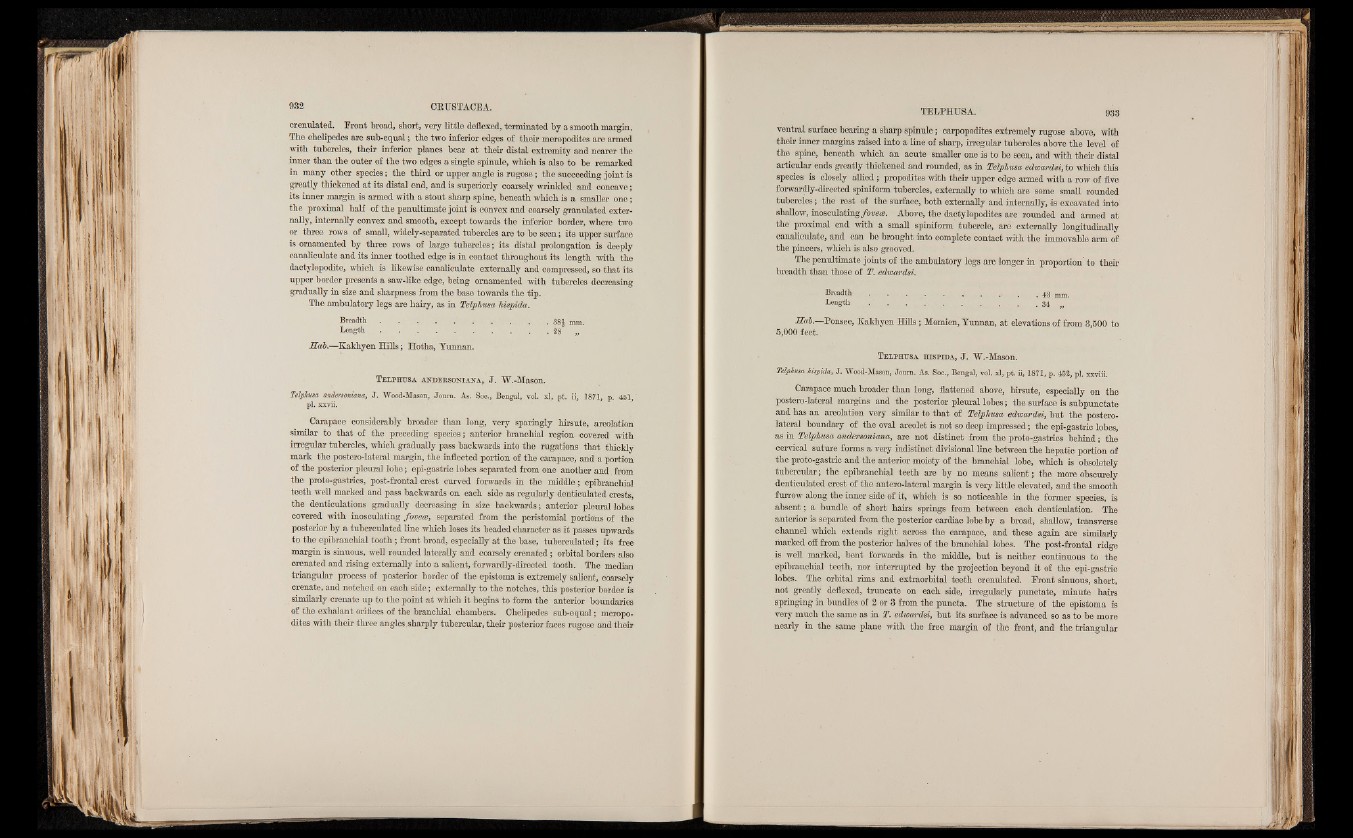
crenulated. Eront broad, short, very little deflexed, terminated by a smooth margin.
The chelipedes are sub-equal; the two inferior edges of their meropodites are armed
with tubercles, their inferior planes bear at their distal extremity and nearer the
inner than the outer of the two edges a single spinule, which is also to be remarked
in many other species; the third or upper angle is rugose; the succeeding joint is
greatly thickened at its distal end, and is superiorly coarsely wrinkled and concave;
its inner margin is armed with a stout sharp spine, beneath which is a srnn.iw one;
the proximal half of the penultimate joint is convex and coarsely granulated externally,
internally convex and smooth, except towards the inferior border, where two
or three rows of small, widely-separated tubercles are to be seen; its upper surface
is ornamented by three rows of large tubercles * its distal prolongation is deeply
canaliculate and its inner toothed edge is in contact throughout its length with the
dactylopodite, which is likewise canaliculate externally and compressed, so that its
upper border presents a saw-like edge, being ornamented with tubercles decreasing
gradually in size and sharpness from the base towards the tip.
The ambulatory legs are hairy, as in Telphusa hispida.
B re ad th ......................................... . . . . 88| mm.
L e n g th ...............................• . . .28 „
Sab.—Kakhyen Hills; Hotha, Yunnan.
T e l p h u s a a h d e r s o n ia n a , J. W.-Mason.
Telphusa andersoniana, J. Wood-Mason, Journ. As. Soc., Bengal, vol. xl, pt. ii, .1871, p. 451,
pi. xxvii.
Carapace considerably broader than long, very sparingly hirsute, areolation
similar to that of the preceding species; anterior branchial region covered with
irregular tubercles, which gradually pass backwards into the rugations that thickly
mark the postero-lateral margin, the inflected portion of the carapace, and a portion
of the posterior pleural lobe; epi-gastric lobes separated from one another and from
the proto-gastrics, post-frontal crest curved forwards in the middle; epibranchial
teeth well marked and pass backwards on each side as regularly denticulated crests,
the denticulations gradually decreasing in size backwards; anterior pleural lobes
covered with inosculating fovece, separated from the peristomial portions of the
posterior by a tuberculated line which loses its beaded character as it passes upwards
to the epibranchial tooth; front broad, especially at the base, tuberculated; its free
margin is sinuous, well rounded laterally and coarsely crenated; orbital borders also
crenated and rising externally into a salient, forwardly-directed tooth. The median
triangular process of posterior border of the epistoma is extremely salient, coarsely
crenate, and notched on each side; externally to the notches, this posterior border is
similarly crenate up to the point at which it begins to form the anterior boundaries
of the exhalant orifices of the branchial chambers. Chelipedes sub-equal; meropodites
with their three angles.sharply tubercular, their posterior faces rugose and their
TELPHUSA. 933
ventral surface bearing a sharp spinule; carpopodites extremely rugose above, with
their inner margins raised into a line of sharp, irregular tubercles above the level of
the spine, beneath which an acute smaller one is to be seen, and with their distal
articular ends greatly thickened and rounded, as in Telphusa edwardsi,wh i c h this
species is closely allied; propodites with their upper edge armed with a row of five
forwardly-directed spiniform tubercles, externally to which are some small rounded
tubercles; the rest of the surface, both externally and internally, is excavated into
shallow, inosculating fovea. Above, the dactylopodites are rounded and armed at
the proximal end with a small spiniform tubercle, are externally longitudinally
canaliculate, and can be brought into complete contact with the immovable arm of
the pincers, which is also grooved.
The penultimate joints of the ambulatory legs are longer in proportion to their
breadth than those of T. edwardsi.
Breadth . . . 43 mm.
Length .' . 34 j"
Sab.—Ponsee, Kakhyen Hills; Momien, Yunnan, at elevations of from 3,500 to
5,000 feet.
T e l p h u s a h i s p i d a , J. W.-Mason.
Telphusa hispida, J. Wood-Mason, Journ. As. Soc., Bengal, vol. xl, pt. ii, 1871, p. 452, pi. xxviii.
Carapace much broader than long, flattened above, hirsute, especially on the
postero-lateral margins and the posterior pleural lobes; the surface is subpunctate
and has an areolation very similar to that of Telphusa edwardsi, but the posterolateral
boundary of the oval areolet is not so deep impressed; the epi-gastric lobes,
as in Telphusa (mdersonima, are not distinct from the proto-gastrics behind; the
cervical suture forms a very indistinct divisional line between the hepatic portion of
the proto-gastric and the anterior moiety of the branchial lobe, which is obsoletely
tubercular; the epibranchial teeth are by no means salient; the more obscurely
denticulated crest of the antero-lateral margin is very little elevated, and the smooth
furrow along the inner side of it, which is so noticeable in the former species, is
absent; a bundle of short hairs springs from between each denticulation. The
anterior is separated from the posterior cardiac lobe by a broad, shallow, transverse
channel which extends right across the carapace, and these again are similarly
marked off from the posterior halves of the branchial lobes. The post-frontal ridge
is well marked, bent forwards in the middle, but is neither continuous to the
epibranchial teeth, nor interrupted by the projection beyond it of the epi-gastric
lobes. The orbital rims and extraorbital teeth crenulated. Eront sinuous, short,
not greatly deflexed, truncate on each side, irregularly punctate, minute hairs
springing in bundles of 2 or 3 from the puncta. The structure of the epistoma is
very much the same as in T. edwardsi, but its surface is advanced so as to be more
nearly in the same plane with the free margin of the front, and the triangular